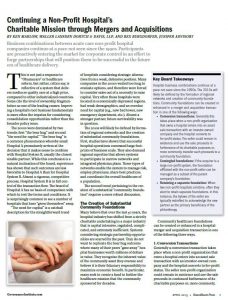Continuing a Non-Profit Hospital’s Charitable Mission through Mergers and Acquisitions
 Business combinations between acute care non-profit hospital companies continue at a pace not seen since the 1990s. Participants are proactively entering the market for corporate control in an effort to forge partnerships that will position them to be successful in the future era of healthcare delivery.
Business combinations between acute care non-profit hospital companies continue at a pace not seen since the 1990s. Participants are proactively entering the market for corporate control in an effort to forge partnerships that will position them to be successful in the future era of healthcare delivery.
This is not just a response to “Obamacare” or healthcare reform, but rather, critics say, is reflective of a system that delivers mediocre quality care at a high price, compared to other industrialized countries. Some cite the level of ownership fragmentation as one of the leading causes. Improving a hospital’s root business fundamentals is more often the impetus for considering consolidation opportunities rather than the broader policy issue.
The 2000s were dominated by two trends: first “the bear hug” and second “the need for capital.” “The bear hug” is a common phenomenon whereby small Hospital A prematurely arrives at the decision that it makes sense to combine with Hospital System B, usually the closest sizable partner. While this conclusion is a natural inclination of the board, experience has shown that such outcomes are less favorable to Hospital A than for Hospital System B. Absent a rigorous, competitive process, Hospital System B is in full control of the transaction flow. The board of Hospital A has no basis of comparison with which to test the terms and conditions. It is surprisingly common to see a number of hospitals that have “given themselves” away.
“The need for capital” is a catchall description for the straightforward trend of hospitals considering strategic alternatives from a weak, defensive position. Many companies in the 2000s waited too long to evaluate options, and therefore were forced to consider sales out of a necessity to raise capital. Very often these hospitals were located in economically depressed regions, had weak demographics, and an overdue need for capital (e.g., new bed tower, new emergency department, etc.). Absent a stronger partner, future survivability was in question.
The 2010s will likely be defined by formation of regional networks and the creation of substantial community foundations. First, studies have shown that successful hospital operations command large footprints of business scale. They also demand regional expertise that allows systems to participate in narrow networks and integrated physician plans. These types of networks enable the system to manage risk, employ physicians, share best practices, and coordinate the overall healthcare of a population.
The second trend pertaining to the creation of a substantial “community foundation” requires a more robust discussion.
Read more *Note: Subscription required.